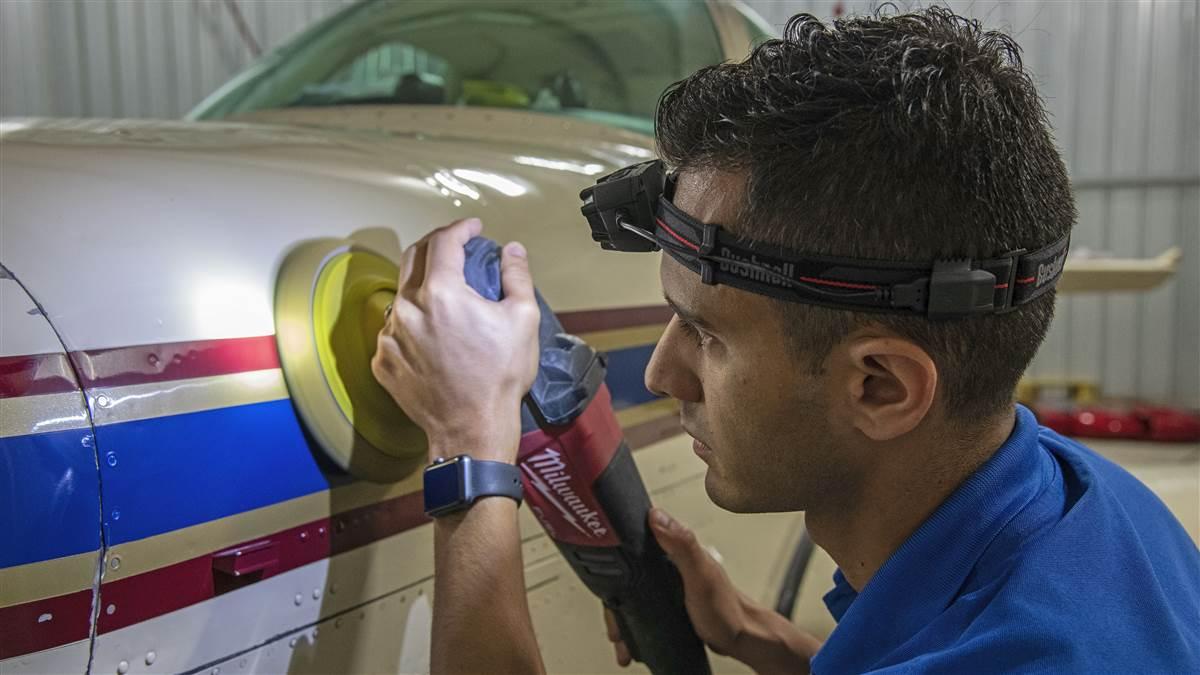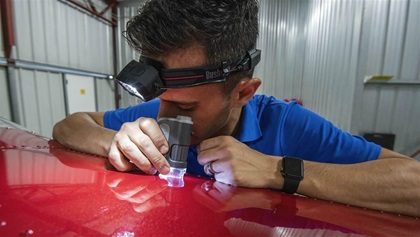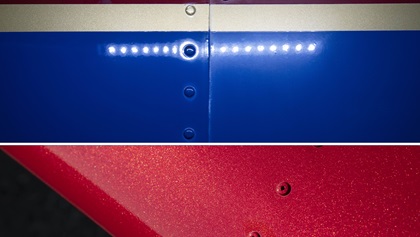Ownership: Get your gloss on
Putting science to work on your paint

 And so began our two-day exercise to restore the paint on my 1972 Beechcraft Bonanza A36, last painted in 1989. While it has mostly been hangared, two years of sitting outside when I first got it in 1999 really did a number on the finish. That, plus many hours of flying through rain—eroding the paint on the leading edges—has left it looking more like a 5 than the 10 I wish it were.
And so began our two-day exercise to restore the paint on my 1972 Beechcraft Bonanza A36, last painted in 1989. While it has mostly been hangared, two years of sitting outside when I first got it in 1999 really did a number on the finish. That, plus many hours of flying through rain—eroding the paint on the leading edges—has left it looking more like a 5 than the 10 I wish it were.
Although not a lot can be done about the rain erosion, much can be done to bring back the luster, restore the gloss, and provide UV protection.
And, indeed, the 1.5 days of effort on the Bonanza made an incredible difference. Zarifkar spent another half day sprucing up my newly acquired 2014 Van’s RV–12 Light Sport aircraft. It was four years old when I bought it, but it had only seen daylight for 33 hours, having been in a hangar for years. So although that new paint looked good, Zarifkar’s efforts made it even glossier—and, more important, the ceramic coating he applied will keep it that way for a long time to come.
 Bored with his job as a chemical engineer, Zarifkar began tinkering around with car detailing projects and soon discovered that most of the products he was using were not very effective, especially over the long term. Putting his education to work, he began to seek products that chemically work with the paint to make long-term improvement to the finish. He ultimately found a line of products that include a ceramic coating that literally binds with the surface paint to provide a high level of UV protection, which makes cleaning a lot easier. That, combined with a paint-restoration process completed before the ceramic is applied, provides a better-than-new finish, as long as the paint is intact to start.
Bored with his job as a chemical engineer, Zarifkar began tinkering around with car detailing projects and soon discovered that most of the products he was using were not very effective, especially over the long term. Putting his education to work, he began to seek products that chemically work with the paint to make long-term improvement to the finish. He ultimately found a line of products that include a ceramic coating that literally binds with the surface paint to provide a high level of UV protection, which makes cleaning a lot easier. That, combined with a paint-restoration process completed before the ceramic is applied, provides a better-than-new finish, as long as the paint is intact to start.
“People are skeptical,” he admits. “It sounds snake-oily, but it works. It lowers maintenance time and provides protection. Even new paint can be improved because we can remove much of the light swirling that you get when polishing new paint.” The process is not a solution for deep scratches or eroded paint.
A pilot and classic Bonanza owner, Zarifkar eventually formed a company, Aviana Aircraft Detailing, and began detailing airplanes full time. A typical job for a four-place single starts at about $2,900. Single-engine turboprops are in the low $3,000 range. The coating makes easy work of removing exhaust stains, a common problem on turboprops. The price doesn’t include his travel and related expenses. Travel costs can be split if there’s more than one airplane on a field. There is no travel cost for airplanes coming to him at any of the Minneapolis reliever airports.
After studying the chemical properties of numerous products, Zarifkar settled on a product line from Gtechniq, which is available only to professional detailers.
The process begins with paint restoration, which includes a low-water wash. The no-rinse solution is diluted 256-to-1 and uses only a few ounces to clean a whole airplane. A citrus-based degreaser worked wonders on the Bonanza’s belly. Next up is paint correction, where Zarifkar uses a low-speed buffer and a light polish to remove oxidation—again a tiny amount of solution is needed, one spritz of polish on the buffer every few minutes. The restoration does an amazing job of bringing back the gloss. Stubborn areas may need a somewhat more aggressive approach. On my Bonanza, the paint around the lower windshield frame was particularly flat and took a lot of extra work. The belly also presented its own challenges, especially just aft of the exhaust stacks. Three decades and thousands of flight hours of hot exhaust really does a number on the paint finish. The results, however, were impressive. Those two spots didn’t end up with the same depth of gloss as the rest of the airframe, but there was significant and noticeable improvement.
Each step is followed by a careful rub-down and further examination using the high-intensity light to ferret out any swirls, especially those left over from previous polishings.
The final step is application of the ceramic coating, which comes in a very small bottle. In total, an airplane the size of a Bonanza will need only about 75 to 100 milliliters—less than three ounces. The coating is wiped on, allowed to dry for a few minutes, and then wiped off.
The coating deepens the gloss even more and makes the surface unbelievably smooth and slippery—and adds UV protection. I’ve had to rethink some preflight procedures: carefully putting the fuel strainer down on the wing; same with the oil dipstick when adding oil. Otherwise, they’d slide right off.
The RV–12 is similarly slippery and remarkably glossy.
Six months later and 75 or so flight hours after the work, both airplanes still look terrific. I’ve ditched all the other cleaners and polishes I used before, especially to remove bugs from the leading edges. After flights, I use a spray bottle with water or the highly diluted no-rinse spray to wipe the bugs off. Occasionally I need a spritz of the citrus cleaner for a tough spot and to remove the belly grease.
Zarifkar says the ceramic coating will remain intact and effective for years, assuming it is well cared for. An occasional wash, avoiding aggressive rubbing, and keeping other chemicals off the surfaces are about all that is required to maintain the finish.
The result is a deep gloss and smooth surface that I thought not possible, especially on the Bonanza’s 30-year-old paint. The deep blue and red stripes look stunning. I had been thinking the airplane needed a new paint job. I’m now putting that off for years.
Email [email protected]



